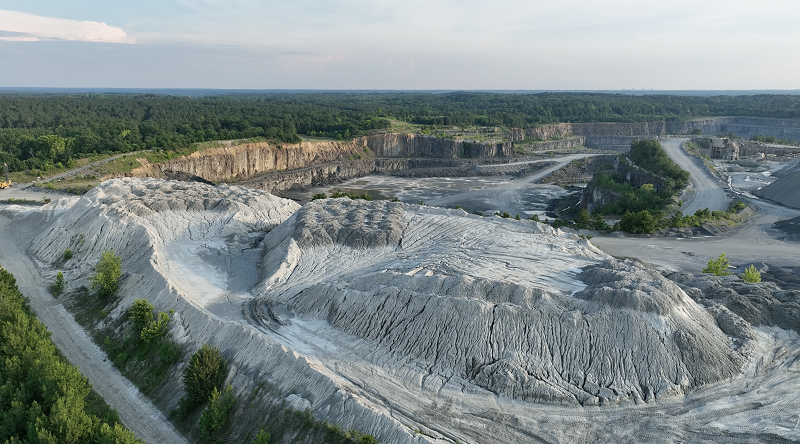
Microsoft Signs Carbon Removal Deal With Lithos Carbon
Published by Todd Bush on September 27, 2024
Microsoft Signs Third Rock Weathering Carbon Capture Deal This Week
Microsoft has signed another carbon removal deal with a company that uses crushed rocks to capture carbon out of rainwater. This marks Microsoft's third carbon removal agreement this week, highlighting its ongoing commitment to sustainability and carbon-negative operations.

>> In Other News: Norway: Northern Lights Facilities Completed and Ready to Store CO2
Lithos Carbon this week announced Microsoft as a return customer, having signed a new, three-year agreement to permanently remove CO₂ using enhanced rock weathering (ERW). Lithos Carbon’s newest agreement with Microsoft covers more than 11,400 metric tons of permanent carbon removal.
Natural rock weathering draws CO₂ from the atmosphere, and ERW aims to mimic and accelerate this natural process. This technique allows rainwater to react with basalt, trapping CO₂ as bicarbonate, which eventually flows into the ocean.
Lithos Carbon deploys basalt on croplands; rainwater reacts with the silicate rock, trapping the CO₂ and releasing minerals that enrich the soil. The trapped CO₂ is then sequestered as bicarbonate, making this process beneficial both for carbon capture and soil health.
"Microsoft has been a worldwide leader in sustainability, and we’re thrilled to work with them as a backer of our catalytic, data-driven project," said Mary Yap, CEO of Lithos Carbon. "Our mission is to transform cropland into carbon capture centers, with a goal of removing a billion tons of CO₂ over the next decade."
Lithos Carbon has previously delivered 500 tons of carbon removal for Microsoft by deploying ultra-fine, organic-grade volcanic basalt rock dust on US farmland. The company continues to work with over 100 farmers across nine states, demonstrating the scalability of its solution.
"Supporting innovative solutions is central to Microsoft’s carbon removal strategy," said Brian Marrs, Senior Director of Energy Markets at Microsoft. "Lithos Carbon’s improvements in enhanced rock weathering systems align perfectly with our pursuit of high-quality carbon dioxide removal projects."
Microsoft is aiming to be carbon-negative by 2030 and is actively pursuing this goal by signing renewable energy contracts en masse, as well as investing in carbon capture and removal projects that offset its historical emissions. This agreement with Lithos Carbon is part of Microsoft's broader strategy to combat climate change through innovative, scalable technologies.
This is the third carbon removal deal Microsoft has announced this week, and the third involving ERW.
The cloud company also announced a follow-on deal with Undo, which will remove 15,000 tonnes of CO₂ by spreading 65,000 tonnes of crushed silicate rock across the UK and Canada. This is the second deal Microsoft has signed with Undo, further cementing its leadership in the carbon removal space.
In addition, Microsoft has partnered with Eion, which will deliver 8,000 tons of CO₂ removal over the next five years through its own ERW process. Eion's deployment of olivine on Mid-Atlantic farmlands after the Fall harvest adds another layer to Microsoft's robust carbon removal portfolio.
About Lithos Carbon
Lithos Carbon uses enhanced rock weathering to capture carbon dioxide from the atmosphere. Its technology deploys finely crushed basalt rock on croplands, which reacts with rainwater to sequester CO₂ while enriching the soil. The company aims to remove a billion tons of carbon dioxide within the next decade through partnerships with major corporations and farmers.
Subscribe to the newsletter
Daily decarbonization data and news delivered to your inbox
Follow the money flow of climate, technology, and energy investments to uncover new opportunities and jobs.
Latest issues
-
Nebraska's 3-Plant Ethanol CCS Gamble Pays Off Big
Inside This Issue 🌽 Nebraska's 3-Plant Ethanol CCS Gamble Pays Off Big 🧊 New Evaporative Crystallizer Design Accelerates Direct-Air Carbon Capture ✈️ From SAF to Solar: DHL’s Bold Steps Toward Net...
-
SAF Output Doubled, So Why Is IATA Sounding Alarms?
Happy New Year from Decarbonfuse! As we wrap up 2025, we want to thank you for being part of the growing Decarbonfuse community. Your engagement and feedback have helped make this platform a trust...
-
$213 Per Tonne: Inside the Latest Multi-Pathway CDR Deal
Inside This Issue 💸 $213 Per Tonne: Inside the Latest Multi-Pathway CDR Deal 🏛️ Clean Energy Technologies Affiliate Vermont Renewable Gas Advances Regulatory Review 💧 Fusion Fuel’s BrightHy Soluti...
Company Announcements
-
Plug To Participate In Goldman Sachs Energy, CleanTech & Utilities Conference
SLINGERLANDS, N.Y., Jan. 06, 2026 (GLOBE NEWSWIRE) -- Plug Power, Inc. (NASDAQ: PLUG), a global leader in comprehensive hydrogen solutions for the hydrogen economy, announced its participation in t...
-
Venture For ClimateTech Accelerator Launches Applications For Cohort 6
Each Selected Startup Receives Up to $50,000 and High-Touch Support ROCHESTER, N.Y., Jan. 06, 2026 (GLOBE NEWSWIRE) -- Venture For ClimateTech (V4C), a global accelerator supporting early-stage cl...
-
MIAMI, Jan. 06, 2026 (GLOBE NEWSWIRE) -- UMeWorld Limited (OTC: UMEWF), a Delaware-incorporated company advancing enzymatic biorefining solutions for renewable fuels and functional nutrition, today...
-
ATHENS, Greece, Jan. 06, 2026 (GLOBE NEWSWIRE) -- Capital Clean Energy Carriers Corp. (the “Company”, “CCEC,” “we” or “us”) (NASDAQ: CCEC), an international owner of ocean-going vessels, today anno...